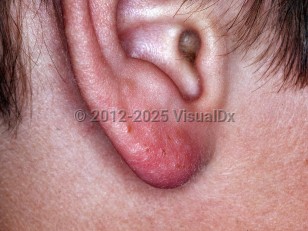Juvenile spring eruption
Alerts and Notices
Important News & Links
Synopsis

Juvenile spring eruption (JSE), also known as juvenile spring eruption of the ears, is considered to be an unusual, localized variant of polymorphous light eruption (PLE or PMLE) that typically occurs in childhood. JSE occurs most commonly in male children aged 5-12 years but has been reported in young adult males. As opposed to PLE, which typically affects women in their second and third decade, JSE overwhelmingly affects males (97% according to one review). The condition can affect all skin phototypes.
The most common time for presentation of JSE is in the early spring when the weather is still cold. It is thought that sunlight exposure and cold weather both have a role in the induction of JSE. There is a tendency for JSE to occur in small epidemics, for example, at boys' schools or among a group of soldiers.
JSE is characterized by grouped small papules, papulovesicles, or true vesicles on the helices of the ears. Lesions typically develop within 24-48 hours after exposure to sunlight and cold conditions and are typically pruritic. Vesicles may rupture and crust. Lesions resolve spontaneously, usually within 2 weeks, with minimal to no scarring. There are no systemic symptoms or organ involvement. Recurrence during the following spring has been reported. The condition tends to improve with age and resolve in young or middle adulthood.
Pathogenesis is thought to be a delayed-type hypersensitivity to an endogenous photoinduced allergen and/or lack of ultraviolet radiation (UVR)-induced immunosuppression. The spectrum of UV light that induces the condition is UVA in most cases; rarely, UVB or visible light may incite JSE.
The most common time for presentation of JSE is in the early spring when the weather is still cold. It is thought that sunlight exposure and cold weather both have a role in the induction of JSE. There is a tendency for JSE to occur in small epidemics, for example, at boys' schools or among a group of soldiers.
JSE is characterized by grouped small papules, papulovesicles, or true vesicles on the helices of the ears. Lesions typically develop within 24-48 hours after exposure to sunlight and cold conditions and are typically pruritic. Vesicles may rupture and crust. Lesions resolve spontaneously, usually within 2 weeks, with minimal to no scarring. There are no systemic symptoms or organ involvement. Recurrence during the following spring has been reported. The condition tends to improve with age and resolve in young or middle adulthood.
Pathogenesis is thought to be a delayed-type hypersensitivity to an endogenous photoinduced allergen and/or lack of ultraviolet radiation (UVR)-induced immunosuppression. The spectrum of UV light that induces the condition is UVA in most cases; rarely, UVB or visible light may incite JSE.
Codes
ICD10CM:
L56.4 – Polymorphous light eruption
SNOMEDCT:
238526000 – Juvenile spring eruption
L56.4 – Polymorphous light eruption
SNOMEDCT:
238526000 – Juvenile spring eruption
Look For
Subscription Required
Diagnostic Pearls
Subscription Required
Differential Diagnosis & Pitfalls

To perform a comparison, select diagnoses from the classic differential
Subscription Required
Best Tests
Subscription Required
Management Pearls
Subscription Required
Therapy
Subscription Required
References
Subscription Required
Last Reviewed:05/16/2021
Last Updated:06/06/2021
Last Updated:06/06/2021
Juvenile spring eruption

